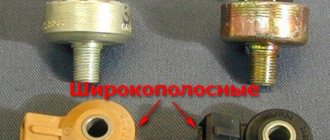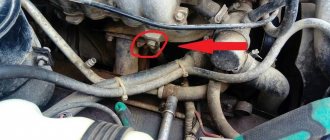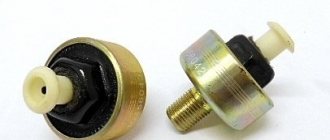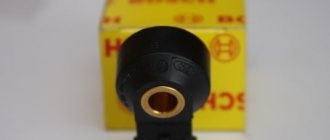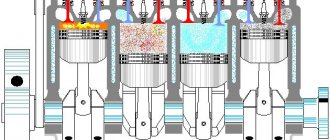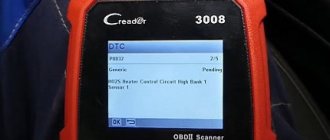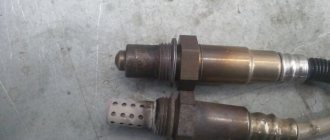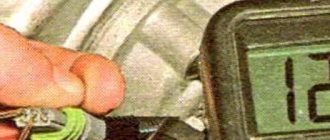Many malfunctions recorded by the on-board computer are accompanied by the “Check Engine” light coming on.
To clarify the source of the malfunction, a diagnostic scanner is used, which produces error codes that can be used to specify where and what kind of breakdown occurred. Methods for eliminating it also depend on this. Today we will talk about error code P0325, which is not that rare and indicates problems with detonation.
Description and meaning of error code P0325
If you find a non-Russian description of error codes, then opposite P0325 in most cases there will be the phrase Knock Sensor in Circuit Malfunction, which means a malfunction in the knock sensor circuit.
In simple terms, error code P0325 indicates that the on-board computer does not receive data from the knock sensor. And the reason may lie either in the DD itself (output voltage is too high or low) or in the electrical circuit in the area between the knock sensor and the power unit control unit (poor contact, open circuit).
DEVICE AND PURPOSE
The basis of the knock sensor (DS) is a piezoelectric element. When mechanically applied, an electrical impulse is generated on it, this impulse is sent to the engine control unit. The electronics detects the occurrence of detonation and, based on the data obtained, adjusts the ignition angle, thereby protecting the internal combustion engine (ICE) from mechanical damage.
To find out where the knock sensor is located on a VAZ 2114, you need to open the hood and look under the cylinder head between the second and third cylinders; it is installed on the internal combustion engine block (this can be seen in the figure above). On a 16-valve engine it will be more difficult to see right away; the cylinder head is more massive and blocks the view.
There are two types of DD:
- Resonant (single-contact),
- Broadband (two-contact) sensors.
What types of DD are there?
The resonant knock sensor was installed on early releases of VAZ 2113, VAZ 2114 and VAZ 2115 cars (they are completely interchangeable). It is rarely found on sale lately, and the price of the part is quite high. A single-contact knock sensor works on the principle of capturing the detonation frequency, while a broadband (two-contact) sensor receives the entire noise band, and then detects detonation noise in it. These devices are not interchangeable, as they operate on different principles. Replacing the wiring does not solve the problem, so when remaking the system, you also have to change the electronic control unit (ECU).
But replacing the ECU is ultimately worth it, given the difference in price of the parts. A resonant DD from GM costs approximately 2,600 rubles. At the same time, the price of broadband DD is in the range of 230-320 rubles. If desired, a spare part can be found even cheaper, for example, a two-pin DD manufactured by StartVolt is sold at a price of 170-210 rubles. It makes sense to redo the entire system once rather than constantly have to worry about finding and replacing a single-contact knock sensor.
Symptoms of the error
As is the case with many other malfunctions, symptoms indicating the occurrence of a knock sensor error P0325 may indicate a number of other malfunctions associated with DD. So it is difficult to identify a breakdown based on one sign; it may require diagnosing the car using an electronic scanner.
So, the symptoms indicating a malfunction in the DD circuit:
- The Check Engine light is on (which can indicate anything);
- the power unit control unit operates in emergency mode;
- sometimes these symptoms are accompanied by detonation processes in the engine;
- the power (dynamic) characteristics of the motor have deteriorated;
- In XX mode the engine is unstable.
All of these symptoms are also characteristic of a problem such as late ignition (a problem typical for cars with carburetor power units).
What does it indicate?
The appearance of error P0325 indicates incorrect operation of the knock sensor, or more precisely, the presence of faults in its circuit. The device is installed on the cylinder block or intake manifold. It is designed to detect engine detonation using a piezoelectric element located in it.
The sensor perceives vibration of the cylinder blocks as an oscillatory movement. The pressure is then converted into a voltage signal and transmitted to the engine control module. Error code P0325 occurs when the sensor voltage level is too low or, conversely, too high. This does not have a critical impact on the operation of the engine as a whole, and the driver has time to safely get to the service station.
Often, along with the P0325 error, related errors appear, which also indicate problems with detonation. All of them occur due to damage to the sensor or the use of low quality fuel.
- P0326 – the sensor signal is outside the permissible limits.
- P0327 - decrease in the signal level of the knock sensor.
- P0328 - signal level exceeded.
How to diagnose the error
If the symptoms implicitly indicate that the cause of problems with the car may be a knock sensor or electrical wiring, you can clarify the diagnosis using computer diagnostics, carried out according to the following algorithm:
- The first step is to reset the error. If it no longer appears after this, we can assume that it was simply a failure of the “brains” of the power unit control unit, otherwise we move on;
- We connect a device with installed software to the diagnostic connector of the car, start the engine, let it warm up, raise the speed to a level exceeding 1300 rpm. If the error does not disappear, proceed to the next step;
- we check the DD connector for contamination, if present, using household cleaning compounds that are harmless to the plastic case, remove dirt, traces of technical fluids, and debris;
- We use a multimeter to check the integrity of the electrical wiring going to the DD with the ignition on;
- If the wiring is intact, we check the functionality of the knock sensor itself. We dismantle it and, using the same multimeter, measure the internal resistance of the DD. We switch the measuring device to ohmmeter mode and look: if the sensor resistance is significantly lower than 5 megohms, it requires replacement;
- if everything is normal with the resistance, switch the multimeter to voltmeter mode (measuring direct voltage) with a sensitivity of about 200 mV, then connect the terminals (probes) of the device to the DD terminals. Then we perform the following manipulation: take a screwdriver, wrench or similar object and knock it in the place adjacent to the sensor mount, simulating detonation. The needle of the measuring device will twitch, but will eventually settle at a certain value. If it does not respond to knocks, the sensor may be faulty and should go in the trash. But sometimes a lack of response occurs even in working devices, so this method cannot be called ideal;
- finally, make sure that the error was not caused by other reasons - for example, strong vibration of a running engine, knocking of hydraulic compensators, poor fastening of the knock sensor to the power unit unit.
Signs of a malfunctioning knock sensor
Resistance that should be in the sensor in good condition
Before considering the causes, it is necessary to look at the symptoms of the malfunction. So, let's look at what could be a warning sign that the knock sensor has failed:
- The engine is losing power.
- Overclocking potential drops.
- Fuel consumption has increased.
- The CHECK light came on on the instrument panel.
- Smoky exhaust.
- Presence of detonation.
- The engine started to stall.
Of course, an important reason for the failure of the knock sensor is the fuel mixture, namely the quality of gasoline itself. The lower the octane number, the lower the resistance to detonation. If the fuel detonates, it will not completely burn through the engine and you will hear the muffler firing.
Knock sensor diagnostics
The sensor is checked with a multimeter. In this case, the sensor is “knocked” with a screwdriver
To diagnose the knock sensor, it is removed from the engine and a voltmeter with a measurement limit of up to 200 mV is connected to it.
Next, they “knock” the sensor on a hard surface and look at the voltmeter readings. When tapping, the readings should change. If they do not change, this means that the sensor is not working. If they change, then the sensor readings change, but whether they are correct is in question!
How to get rid of the error
The method of getting rid of such a malfunction as error P0325 depends on what exactly led to its appearance, that is, according to the results of the diagnostics, the algorithm of which we described above. If it's all about the wiring, change it (or eliminate the short circuit). If there is poor contact, we do everything necessary to restore it. If the reason is in the sensor itself, in most cases it is impossible to do without replacing it - it, like most measuring instruments, cannot be repaired.
After fixing the problem, you must reset the error, although this event usually occurs automatically. The simplest way is to remove the battery terminal for 15-20 seconds and return it to its place. This is enough for our error (and all others) to disappear from the ECU memory.
If diagnostics using a scanner showed, in addition to error P0325, fault codes with similar numbers (P0326, P0327, P0328), you can rest assured that the problem lies in the sensor itself - the likelihood of this is very high.
Thus, error P0326 indicates that the sensor output signal is too large or, conversely, small, and does not fit into the permissible range. Error code P0328 says about the same thing - the output voltage of the DD exceeds the threshold value.
Tips to Avoid P0325 in the Future
An improperly installed knock sensor is the most common cause of the P0325 code. Loosely connected wires can become loose over time due to engine vibration. Damaged or broken wires also often cause diagnostic trouble codes, not just P0325, but many other errors related to sensors on the engine.
Take extra time to check all wires any time you install or repair anything on your engine. Make sure the connections are secure and there are no objects on the wires that could cause damage or short circuits.
Previous Post Trouble P0108 - Manifold Absolute Pressure Sensor High Signal
Next Post Trouble P0101 - Mass Air Flow Sensor Range/Performance
Diagnostics
There are two ways to diagnose the condition of car systems. Let's start with the first one, which does not involve the use of additional equipment.
To start the self-diagnosis function, you need to press a button that resets the mileage for the day. Turn on the ignition. You will see how the arrows on the instruments begin to move from one position to another. This means that the diagnostics of the VAZ 2110 has been launched and information has begun to flow from the phase sensors to the ECU. After the process is completed, the RAM will transmit numbers to the display that will show the state of the car’s systems.
VAZ 2110 car
Decoding combinations
When the self-diagnosis is completed and the number 0 is displayed, this means that everything is in order with the vehicle and all systems are working as expected:
- if 1 is displayed, this indicates that there are problems with the microprocessor or the RAM is failing;
- 4 — high voltage in the network, more than 16 V;
- if 8, then low.
If there is not one fault, but several, then a figure equal to the sum of faults will be displayed. If 6 lights up, then this will mean the sum of the numbers 2 and 4. If 14, then most likely there are three malfunctions at once, namely 2, 4 and 8.
The simplest diagnostics that is available to the driver without the use of additional equipment. It will, of course, help identify some faults, as well as show the condition of the components and systems of the VAZ 2110 as a whole. But to specifically identify all faults and decipher information coming from phase sensors, additional tools are needed. For example, the on-board computer STATE, which provides more data.
Daily mileage reset button
Under what conditions is it diagnosed?
To diagnose error P0325 as accurately as possible, a number of conditions must be met.
- First of all, the possibility of false positives should be eliminated. Using a diagnostic scanner, reset the error and perform a test drive. If the P0325 error code appears again, go to the next step.
- Perform a performance check of the knock sensor (knock sensor). For these purposes, a multimeter is used, which determines the voltage level of the sensor under pressure. Then the circuit of the electronic control unit is checked for breaks.
- If you do not have a multimeter, the test can be performed mechanically. It's very simple. To do this, it is necessary to lightly hit the engine at idle speed as close as possible to the location of the knock sensor. If this device is working properly, the ignition angle will automatically change and the speed will decrease.
- Test the performance of the engine control module by contacting a dealer service center.
